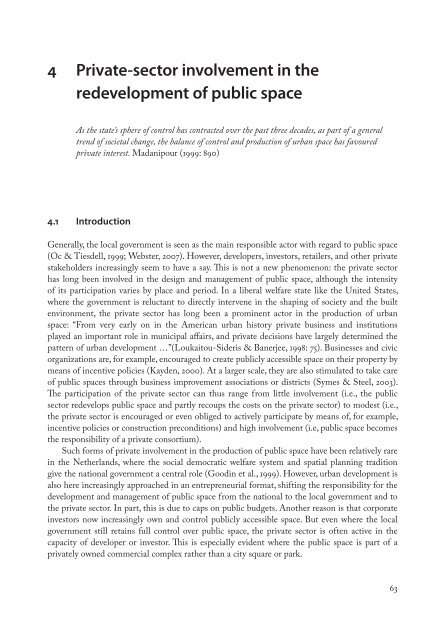Changing public space
Changing public space
Changing public space
You also want an ePaper? Increase the reach of your titles
YUMPU automatically turns print PDFs into web optimized ePapers that Google loves.
4 Private-sector involvement in the<br />
redevelopment of <strong>public</strong> <strong>space</strong><br />
As the state’s sphere of control has contracted over the past three decades, as part of a general<br />
trend of societal change, the balance of control and production of urban <strong>space</strong> has favoured<br />
private interest. Madanipour (1999: 890)<br />
4.1 Introduction<br />
Generally, the local government is seen as the main responsible actor with regard to <strong>public</strong> <strong>space</strong><br />
(Oc & Tiesdell, 1999; Webster, 2007). However, developers, investors, retailers, and other private<br />
stakeholders increasingly seem to have a say. This is not a new phenomenon: the private sector<br />
has long been involved in the design and management of <strong>public</strong> <strong>space</strong>, although the intensity<br />
of its participation varies by place and period. In a liberal welfare state like the United States,<br />
where the government is reluctant to directly intervene in the shaping of society and the built<br />
environment, the private sector has long been a prominent actor in the production of urban<br />
<strong>space</strong>: “From very early on in the American urban history private business and institutions<br />
played an important role in municipal affairs, and private decisions have largely determined the<br />
pattern of urban development …”(Loukaitou-Sideris & Banerjee, 1998: 75). Businesses and civic<br />
organizations are, for example, encouraged to create <strong>public</strong>ly accessible <strong>space</strong> on their property by<br />
means of incentive policies (Kayden, 2000). At a larger scale, they are also stimulated to take care<br />
of <strong>public</strong> <strong>space</strong>s through business improvement associations or districts (Symes & Steel, 2003).<br />
The participation of the private sector can thus range from little involvement (i.e., the <strong>public</strong><br />
sector redevelops <strong>public</strong> <strong>space</strong> and partly recoups the costs on the private sector) to modest (i.e.,<br />
the private sector is encouraged or even obliged to actively participate by means of, for example,<br />
incentive policies or construction preconditions) and high involvement (i.e, <strong>public</strong> <strong>space</strong> becomes<br />
the responsibility of a private consortium).<br />
Such forms of private involvement in the production of <strong>public</strong> <strong>space</strong> have been relatively rare<br />
in the Netherlands, where the social democratic welfare system and spatial planning tradition<br />
give the national government a central role (Goodin et al., 1999). However, urban development is<br />
also here increasingly approached in an entrepreneurial format, shifting the responsibility for the<br />
development and management of <strong>public</strong> <strong>space</strong> from the national to the local government and to<br />
the private sector. In part, this is due to caps on <strong>public</strong> budgets. Another reason is that corporate<br />
investors now increasingly own and control <strong>public</strong>ly accessible <strong>space</strong>. But even where the local<br />
government still retains full control over <strong>public</strong> <strong>space</strong>, the private sector is often active in the<br />
capacity of developer or investor. This is especially evident where the <strong>public</strong> <strong>space</strong> is part of a<br />
privately owned commercial complex rather than a city square or park.<br />
63




